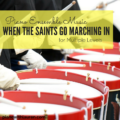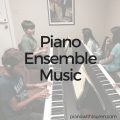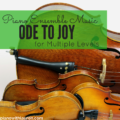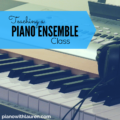This post may contain affiliate links. As a Sheet Music Plus and Amazon Associate, I earn from qualifying purchases. That means I make a small commission (at no additional cost to you) if you purchase something from an affiliate link.
This year, I’ve been teaching a piano ensemble class on the first Saturday of each month. It’s an optional group class that I offer for students who enjoy playing together. Because I have no exact age range for the class, I’ve been arranging Piano Ensemble Music to work for groups of various levels. Each piece includes individual parts for melody, harmony, and bass. Once students master their part, they can try a more advanced variation of it. If there are older students in the class, they can start with one of the more advanced variations of the harmony.
I added a small keyboard lab to my studio last year with four keyboards, but the Piano Ensemble Music can easily be used with one or two pianos. Read below for a few different ways to use the Piano Ensemble Music.

One Piano, One Student
- A beginning student can learn the melody in its simplest form and then try the advanced variation.
- The student can play the piece like a lead sheet by playing the melody in the right hand and harmony in the left hand.
One Piano, Two Students
- Two students can play one of the pieces as a duet. One student can play the melody while the other student plays the harmony. The students could also learn both parts and practice accompanying each other.
- If a beginning student learns the melody, the teacher could play the duet with the student.
- The music works perfectly for siblings as well. The younger sibling can play the melody while the older sibling plays the accompaniment. There are multiple levels of accompaniment part to choose from in each ensemble music pack.
One Piano, Three Students
- One student could play the melody high on the piano, one student could play the harmony in the middle range of the piano, and the third student could play the bass notes low on the piano.
Two Pianos, Four Students
- The parts of melody, harmony, and bass notes could be distributed among the four students. For example: Piano 1 could have melody and harmony while Piano 2 has melody and bass notes. Any configuration would work!
- If you don’t have two pianos, you could use one piano and one keyboard so that students can practice playing together.
Check out the new holiday piano ensemble pieces:



Lauren teaches piano to students of all ages. She enjoys creating resources for her students and teachers. She is the author of Ready for Theory®. For personalized help, check out the consultations page for teachers.




